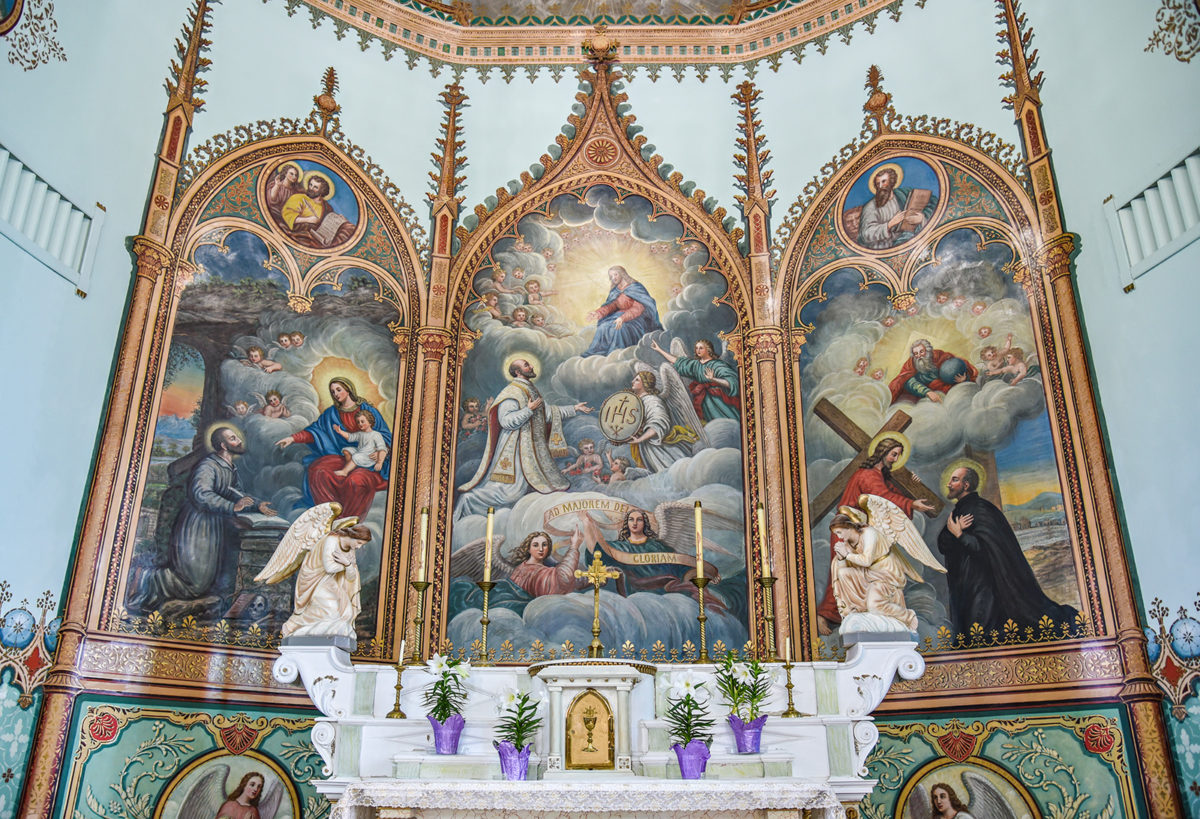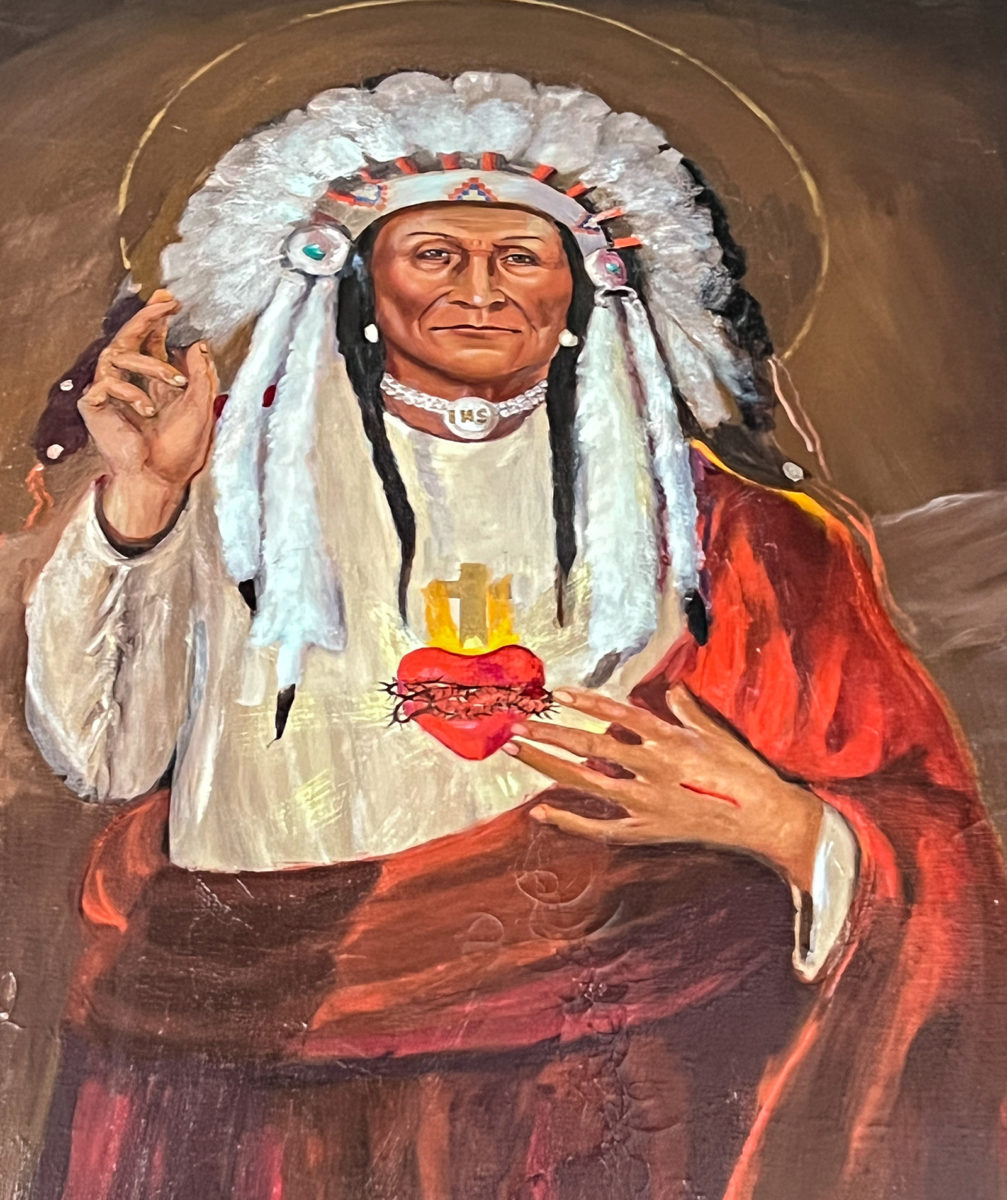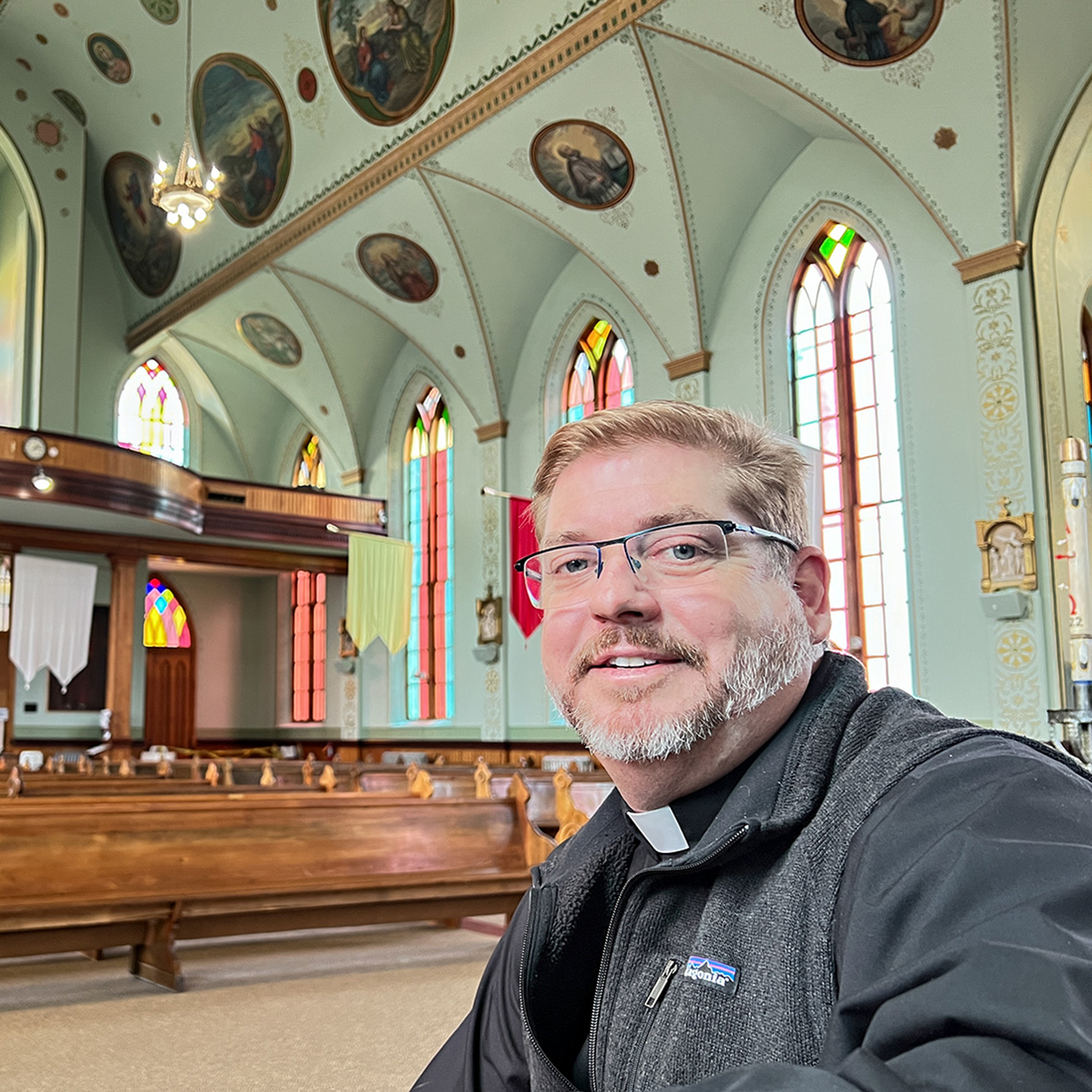Tucked in trees and bounded by quiet streets, the St. Ignatius Mission has had an unassuming presence for many decades. But a recently completed four-year, $1.6 million project to restore and preserve the murals and ornate details that adorn the interior of the 130-year-old church have made it a Montana masterpiece.
As word of the restoration work has spread, a growing number of visitors have been lured off U.S. Highway 93 to take in the historic church in St. Ignatius, situated in the heart of the Mission Valley. Some are tourists but “we also get a lot of local people who have never been here before,” says Rev. C. Hightower, the parish priest who helped lead the restoration project. “It’s on everybody’s radar now.”
Stepping through the church’s heavy doors, visitors are quickly greeted by a symphony of stained glass and 58 hand-painted murals on the walls and ceilings. On a sunny afternoon, the interior of the church can take on a heavenly glow. While Hightower can quickly share the religious stories portrayed in many of the murals, he knows not all who visit see the big church in the little town on the Flathead Indian Reservation through the same lens. “I can tell you the way most people react,” he says. “They say ‘what is this doing here?’”
The answer to that question stretches back almost 170 years. The St. Ignatius Mission was founded in 1854 by Jesuit missionaries, including Father Peter DeSmet, who also played a big role in establishing St. Mary’s Mission near present-day Stevensville in 1841. The Jesuits, “black robes” to native inhabitants, were invited to the Bitterroot and Mission valleys by tribal delegations that traveled to St. Louis. In the years after its establishment, the St. Ignatius Mission grew to include flour and lumber mills, boarding schools for boys and girls, a hospital and became home not only to Jesuits but two orders of Catholic nuns.

In ensuing years, the Flathead reservation was established and Salish inhabitants living in the Bitterroot were forced to move north to the Jocko and Mission valleys, with the last group making the bitter walk north to the reservation in 1891. That’s the same year construction of the current church began, with bricks fired from local clay and lumber from nearby forestland.
The boarding schools withered over the decades but the church endures. Today, tribal members represent a healthy portion of the parishioners. Many others, while not officially parish members, regard the historic structure as “their church,” Hightower says.
About a decade after the completion of the church, which was added to the National Register of Historic Places in the 1970s, Joseph Carignano, a Jesuit brother, began to paint the detailed murals. Remarkably, historians believe that Carignano, whose official duties at the mission, at least initially, included being a cook and handyman, had no formal training in art.
“I don’t think there was any question he was untrained,” says H. Rafael Chacon, a professor of art history and director of the University of Montana’s Museum of Art & Culture in Missoula. “He was a good painter, no doubt about it. This was someone who was highly skilled and very adept at what he did.”

Carignano was prolific. Before arriving at the mission in St. Ignatius, he painted murals at St. Francis Xavier Church in Missoula. His portfolio includes work at a decommissioned church in Butte, the Cataldo Mission in North Idaho, Gonzaga University in Spokane, churches on the Oregon Coast and in Yakima, Wash., where he died in 1912.
Production aside, Chacon says many of the murals likely reflect Italian paintings from the Renaissance and Baroque periods, prints of which might have inspired Carignano, who was born in Turin, Italy in 1853.
“I would actually call him an inventive copyist,” Chacon says. “He copied a lot of other people’s work,” a fact that doesn’t diminish Carignano’s paintings. “He is a very interesting character. Clearly these projects demonstrate a great ambition for someone without any academic training. That, to me, is pretty inspiring.”
While the mission church’s interior has seen physical changes over the decades, including earlier attempts to conserve the murals and the addition of large stained-glass windows in the 1950s, time had taken its toll. Hightower notes that financial issues in the 1970s prompted services to be held in the basement while the main church was left unheated for lengthy periods. The irregular temperature control likely damaged the murals.

When the priest arrived at the mission parish in 2017, the plaster in the murals was in really bad shape. “We were actually having big pieces of the plaster fall to the ground,” he says. In some instances, cheesecloth and rice paper were used to hold the plaster in place. “It was at the point that if we didn’t restore it, we were going to lose it.”
The urgency of the situation had been recognized by previous priests and parishioners, who had lined up Custom Plaster, a repair and restoration company based in Boise, Idaho, to evaluate the murals and do repairs. The cost estimate for the work was an eye-popping $1.2 million, a staggering sum in St. Ignatius.
“This community is wealthy as far as tradition, and wealthy as far as land,” Hightower says. “But, it’s not a cash community.”
But enough money was scraped together to get the restoration project started, bolstered by contributions from visitors to a donation box in the rear of the church.

Greg Marsters, who heads Custom Plaster, and a rotating cast, including his daughter, got to work. Often working on tall scaffolding, the crew cleaned and repaired the murals, in many cases removing a varnish that was applied in the 1950s that made them more brittle and dulled their appearance.
Lofty work in the church’s upper vault got an unlikely boost from the pandemic. The church was closed, which made it possible for scaffolding to be left in place in the church’s center aisle. Along with repairing the murals, Marsters and crew added detailed scroll work on the church walls. The work had been covered some time ago in an earlier remodeling project.
After four summers of steady work, Marsters and helpers returned to the church this spring to finish up details on the restoration, which had a final cost of $1.6 million. With a resume that includes restoration work on all sorts of historic structures across the Pacific Northwest, Marsters takes pride in the work in St. Ignatius.
“This is my favorite project ever,” he says. “I’m thrilled we got the funding and time to do it.” With an interest in Native American art and its preservation, he was able to meet a number of parishioners and local folks who stopped in to view the progress and share stories. “At this point, I feel like I am part of the community.”
The murals and other art elements in the church will need continual care “but we’ve extended the life of the building considerably,” Marsters says. “Plus, it looks great, if I do say so myself.”
While the murals and interior details are completed, Hightower has a wish list of future restoration projects. The front stairs need work and the roof is due for repair, an undertaking that could involve adding dormers, which were an original part of the church. And there is more art in need of preservation.
“We have quite a bit of statuary that hasn’t been restored yet,” he says. “It just wasn’t in the budget.”
And there are the two colorful paintings on the rear wall of the church. One, titled “Christ as an Indian Chief,” and the other “Indian Madonna,” are the work of Selmer “Sam” Wiprud and his wife, Olive. The paintings originally hung in a church near Arlee but were damaged by a fire and moved to St. Ignatius. The paintings, completed in 1957, were nailed to the wall and the weight of the church’s bell tower has put stress on the paintings, causing cracks and other issues.
“We want to restore them,” Hightower says. “They are very valuable.”
The to-do list seems long but the priest and the parishioners remained committed to do as much restoration as possible at the historic church.
“It’s been a real grace to be part of this project,” Hightower says, glancing up at the Carignano murals. “It’s a thing of beauty.”
